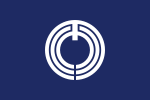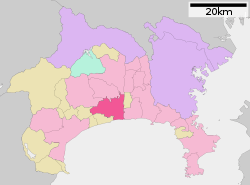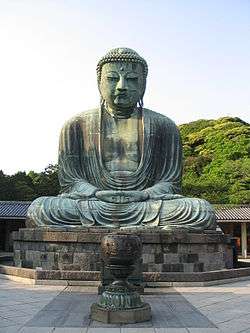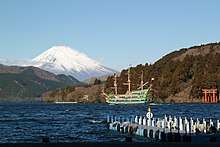Hiratsuka
Hiratsuka (平塚市, Hiratsuka-shi) is a city located in Kanagawa Prefecture, Japan.
Hiratsuka 平塚市 | |
|---|---|
 Hiratsuka City | |
 Flag  Seal | |
 Location of Hiratsuka in Kanagawa Prefecture | |
 Hiratsuka | |
| Coordinates: 35°19′N 139°21′E | |
| Country | Japan |
| Region | Kantō |
| Prefecture | Kanagawa Prefecture |
| Government | |
| • Mayor | Katsuhiro Ochiai (since May 2011) |
| Area | |
| • Total | 67.88 km2 (26.21 sq mi) |
| Population (April 1, 2017) | |
| • Total | 257,877 |
| • Density | 3,800/km2 (9,800/sq mi) |
| Time zone | UTC+9 (Japan Standard Time) |
| - Tree | Camphor Laurel |
| - Flower | Dianthus |
| - Bird | Egret |
| Phone number | 0463-23-1111 |
| Address | 9-1 Sengenchō, Hiratsuka-shi, Kanagawa-ken 254-8686 |
| Website | www.city.hiratsuka.kanagawa.jp |
As of April 1, 2017, the city has an estimated population of 257,877, with 109,020 households,[1] and a population density of 3,800 persons per km². The total area is 67.88 km².[2]
Geography
Hiratsuka is located on the western Kantō Plain midway between Tokyo and Mount Fuji, and has a 5-kilometer coastline in the Shōnan area on the Pacific Ocean in Sagami Bay.
History
The area around Hiratsuka has been settled since prehistoric times, and mention of the area as part of ancient Ōsumi District, Sagami Province is found in Nara period records. From the Heian period through Kamakura period, the area was divided into shōen controlled by various samurai clans and in the Sengoku period was the site of several battles between the later Hōjō clan of Odawara and the Miura clan. After the defeat of the Odawara at the Battle of Odawara by Toyotomi Hideyoshi, the area came under the control of Tokugawa Ieyasu, who built a summer palace (the Nakahara Goten) in 1596 at the site now occupied by the Hiratsuka City Nakahara Elementary/Primary School. Hiratsuka was retained as tenryō territory after the establishment of the Tokugawa shogunate, and flourished as Hiratsuka-juku, a post town on the Tōkaidō connecting Edo with Kyoto. As the 7th station, it is often depicted in the series of ukiyo-e about the 53 Stations of the Tōkaidō made among others by artists such Hokusai and Hiroshige.
After the Meiji Restoration, Hiratsuka town was founded on April 1, 1889, as part of the new Naka District within Kanagawa Prefecture. It merged with neighboring Suma Town on April 1, 1929, and was proclaimed Hiratsuka City on April 1, 1932.
Prior to World War II, Hiratsuka was the location of the Hiratsuka Navy Ammunitions Arsenal (平塚海軍火薬廠) of the Imperial Japanese Navy and Japan International Aircraft Industries (日本国際航空工業), a Nissan group military aircraft factory. Hiratsuka was largely destroyed on July 16, 1945, during the Bombing of Hiratsuka in World War II. Due to its strategic location and wide beaches, it was also one of the targets for the planned invasion of Japan during the final stages of World War II.
The city quickly rebuilt after the war, annexing several neighboring villages in the mid-1950s to attain its current area. The population exceeded 200,000 by 2001 and Hiratsuka became a special city with increased autonomy from the central government. The current mayor is the independent OCHIAI Katsuhiro (落合克宏) who was elected April 24, 2011, and assumed office on April 30. Previously he had served two terms on the Hiratsuka city council and as council chairperson for the majority of the second term. OCHIAI succeeded Ritsuko ÔKURA the city's first female mayor who served from 2003 to 2011.
Economy
Hiratsuka has a mixed economy, with tax revenue coming from wagers made at Shonan Bank Cycling Velodrome, and several industries located in industrial parks in the outskirts of town. Major plants are operated by Nissan Shatai, Yokohama Rubber Company, Canon, Furukawa Electric, Pilot (pen company) (the famous Namiki pens are produced at Hiratsuka), Kansai Paint, and Mitsubishi Plastics. Nissan Shatai produced the largest employment on the City, but announced the plan to let a factory move to Kanda. Western firms such as Moog and MacDermid Performance Solutions also have a strong presence in this city.[3] Hiratsuka is also a bedroom community for Yokohama and Tokyo, with residents attracted by the "Shōnan lifestyle".
Transportation
Railway
- JR East - Tōkaidō Main Line, Shōnan Shinjuku Line
Highway
- Japan National Route 1, to Tokyo or Kyoto
- Japan National Route 129, to Sagamihara
- Japan National Route 134, to Yokosuka via Kamakura
- Japan National Route 271, to Atsugi or Odawara (toll)
- Odawara-Atsugi Road
- Shinshōnan Bypass
Tourist attractions

- Tanabata festival
- Shonan Bellmare football club, three-time Japanese champions based at Hiratsuka Athletics Stadium
Nearby tourist destination

- Yokohama The largest city after Tokyo. The modern cityscape with the Yokohama Port and Chinatown are popular with tourists.

- Kamakura The ancient capital of the Kamakura period (1185? - 1333), where many historical sites such as the Great Buddha and temples and shrines remain.

- Hakone Hakone is one of the most famous hot spring resorts in Japan. You can enjoy the view of Mt. Fuji and nature such as volcano.
Sister cities
Notable people from Hiratsuka
- Yukari Fukui - voice actress
- Yamanashi Hanzō - general, politician
- Michael Hora - former child actor
- Phongchi - Japanese idol of Vietnamese descent
References
- "Statistics of Hiratsuka City" (in Japanese). Japan: Hiratsuka City. Retrieved 6 May 2017.
- Hiratsuka City Hall (ed.). "Hiratsuka-shi Statistical Documentation" (PDF). Retrieved March 11, 2016.
- "MacDermid Performance Solutions Completes Major Expansion of Japan Facility". Yahoo! Finance. 4 November 2016. Retrieved 2017-06-29.
MacDermid Performance Solutions’ state-of-the-art R&D facility is located in Hiratsuka City and now equipped with enhanced capabilities to accommodate the changing requirements of Japanese customers of both plating chemistry and assembly materials.
External links
| Wikimedia Commons has media related to Hiratsuka, Kanagawa. |
- Official Website (in Japanese)